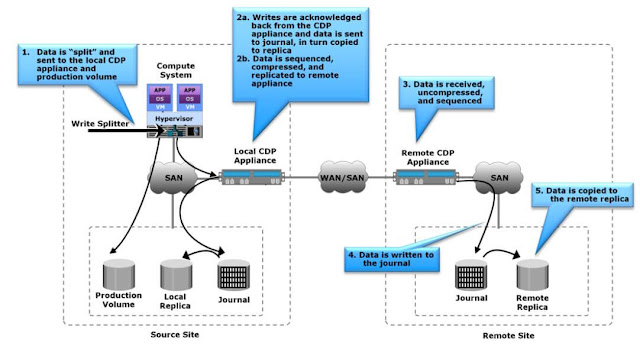In the Network Based replication, the replication occurs at the network layer between the server and the storage systems. By offloading replication from server and storage systems, network-based replication can work across a large number of server platforms and storage systems, making it ideal for highly heterogeneous environments. One of the most widely used Network based replication technique is the Continuous Data Protection (CDP).
What is Continuous Data Protection (CDP) ?
Continuous data protection (CDP) is a network-based replication solution that provides the capability to restore data and VMs to any previous PIT. Traditional data protection technologies offer a limited number of recovery points. If a data loss occurs, the system can be rolled back only to the last available recovery point. Whereas CDP tracks all the changes to the production volumes and maintains consistent point-in-time images.
Also Read: Server or Host Based Replication Overview
This makes the CDP to restore data to any previous PIT. CDP supports both local and remote replication of data and VMs to meet operational and disaster recovery respectively. In a CDP implementation, data can be replicated to more than two sites using synchronous and asynchronous replication. CDP supports various WAN optimization techniques (deduplication, compression) to reduce bandwidth requirements, and also optimally utilizes the available bandwidth.
Also Read: Server or Host Based Replication Overview
This makes the CDP to restore data to any previous PIT. CDP supports both local and remote replication of data and VMs to meet operational and disaster recovery respectively. In a CDP implementation, data can be replicated to more than two sites using synchronous and asynchronous replication. CDP supports various WAN optimization techniques (deduplication, compression) to reduce bandwidth requirements, and also optimally utilizes the available bandwidth.
Continuous Data Protection (CDP) Components
- Journal Volume - It is used to store all the data that has changed on the production volume from the time the replication session started. The journal contains the metadata and data that will allow rollback to any recovery points. The amount of space that is configured for the journal determines how far back the recovery points can go.
- CDP Appliance - A CDP appliance is an intelligent hardware platform that runs the CDP software and manages local and remote data replications.
- Write Splitter - Write splitters intercept writes to the production volume from the server or host and split each write into two copies. Write splitting can be performed at the host , fabric, or storage system level.
How Continuous Data Protection (CDP) Works ?
Pic Credits - EMC
The above diagram explains how CDP local and remote replication operations work and where the write splitter is deployed at the server. Typically the replica is synchronized with the source, and then the replication process starts. After the replication starts, all the writes from the server to the source (production volume) are split into two copies. One copy is sent to the local CDP appliance at the source site, and the other copy is sent to the production volume. Then the local appliance writes the data to the journal at the source site and the data in turn is written to the local replica. If a file is accidently deleted, or the file is corrupted, the local journal enables to recover the application data to any PIT.
Also Read: Types of Backup Techniques
Also Read: Types of Backup Techniques
In case of remote replication, the local appliance at the source site sends the received write I/O to the appliance at the remote (DR) site. Then, the write is applied to the journal volume at the remote site. As a next step, data from the journal volume is sent to the remote replica at predefined intervals. CDP operates in either synchronous or asynchronous mode. In the synchronous replication mode, the application waits for an acknowledgment from the CDP appliance at the remote site before initiating the next write. In the case of asynchronous mode, the local CDP appliance acknowledges a write as soon as it is received. In case of any disaster at the source site, data can be recovered to the required PIT and the service can be restarted at the DR site.
Some vendors also offer continuous data protection for VMs through hypervisor-based CDP implementation. In this deployment, the specialized hardware-based appliance is replaced with virtual appliance which is running on a hypervisor. The write splitter is embedded in the hypervisor. This option protects single or multiple VMs locally or remotely and enables to restore VMs to any PIT. The local and remote replication operations are as similar as network-based CDP replication.
Previous: Storage System Based Replication Overview
Next: Data Migration and Disaster Recovery As a Service (DRAaS) Solutions
Go To >> Index Page
Previous: Storage System Based Replication Overview
Next: Data Migration and Disaster Recovery As a Service (DRAaS) Solutions
Go To >> Index Page
What Others are Reading Now...








0 Comment to "12.4 Introduction to Network Based Replication - Continuous data protection (CDP)"
Post a Comment